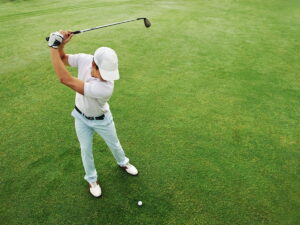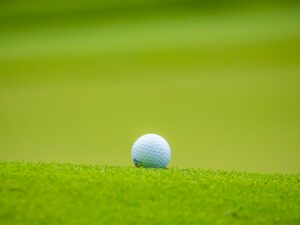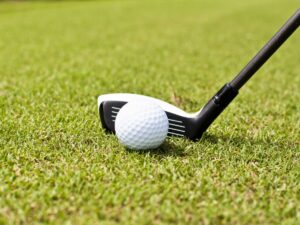
Overlap Golf Grip (Is It Better Than The InterlockGrip )
*This post may contain affiliate links. We are reader supported and earn affiliate commissions when you buy via links found on our site*

- Last Updated on
Contents
Maybe you feel the same way I do that the overlap grip is often pushed as being the better player’s grip. We know that Tiger Woods and even Jack Nicklaus used the interlock grip, but overall, it still gets plenty of attention.
If you are ready to find out if the overlap golf grip is the right fit for your game and how it differs from the interlock, I have all the information you need.
I’ll break down how to choose the right grip, common mistakes you may encounter, and tips for mastering an overlap golf grip.
What Is the Overlap Golf Grip?
The overlap golf grip (also referred to as the Vardon grip) allows the pinky from the right hand (for a right handed golfer) to overlap the index finger of the left hand. Instead of having all ten fingers on your golf club like the ten finger grip, only nine of them will have a direct connection with the club.
An overlap grip has nothing to do with whether the grip is weak or strong, as it does not impact the rotation of the hands on the club. The overlapping simply describes the connection that the fingers have with each other.
Benefits of the Overlap Golf Grip
The main reason golfers like the overlap golf grip is the reduced grip pressure the grip can provide.
The fact that the hands are kind of resting with one partially on top of the other makes it harder to grip the golf club too tightly. However, the lighter grip pressure is not the only benefit; here are a few others to consider.
More comfortable fit for larger hands
If you have large hands, it can be difficult to get your hands comfortable on the back of the club. You may notice that you feel like you run out of room, even with a midsize grip in place.
With an overlap grip, you will feel more comfortable and as if you have more room to place your hands on the club.
Enhanced clubface control
Another benefit of the overlap golf grip is controlling the clubface. The overlap grip tends to give you a bit better feel and control, and it helps create an overall awareness of where the clubface is at all times.
This is why golfers talk about the overlap grip improving the overall feel.
Shot versatility
With an overlap grip, that extra feel and feedback you get can also help you hit various golf shots. If you want to hit a high or low shot, or a draw or a fade, the overlap grip can be quite versatile.
Also Read: Draw vs. Fade – What’s The Difference?
Negatives of the Overlap Golf Grip
It’s golf, so we know that where there is a positive, there is a negative about to come around the corner! The overlap golf grip does have some negatives that you should be aware of if you are going to make a change.
Hard to get it correct in the beginning
I find it hard to teach a beginner the overlap grip; it feels kind of foreign. The ten-finger grip and interlock grip tend to be a bit more similar to what we may see in other sports and give new players that extra comfort.
May feel a lack of power
The overlap grip is not the most powerful feeling grip in the game. If you have smaller hands, the grip feels even less powerful. Keep your hand size in this equation when you look at changing grips.
Could feel as though the club is slipping
In addition to the lack of power, the overlap grip’s lighter grip pressure could be negative for some players. I’m all about not squeezing a club, but you also have to be the one in control.
Overlap vs. Interlock Golf Grip (What To Expect)
The interlock golf grip takes the same two fingers (left index and right pinky), and it interlocks them together instead of overlapping when you grip the club. Interlocking the left and right hand can help give you a very secure feeling when swinging the golf clubs, something that appeals to the higher swing speed player.
Here are a few of the pros and cons along with the main difference between the overlap and interlock golf grip.
Grip stability
In case you haven’t already figured it out, there is no perfect golf grip. If there was a single choice that was clearly better, all professionals would be using it. That said, more pros tend to use the overlap grip.
However, you have to find something that makes you comfortable and stable and, most importantly, able to repeat a golf swing.
The interlocking grip tends to give golfers more stability in their hands. For players with slower swing speeds or poor hand strength, this is a good idea. For others who feel confident in the control they have with the golf club in their hand, grip stability may not be a concern.
Power
The interlocking grip is known to be a bit more powerful.
Does this mean the overlap grip will restrict those 300 yards drive?
Absolutely not!
The interlock grip just makes it a little easier (especially with smaller hands) to get a better grip on the club for those really powerful swings. Power and accuracy don’t always go hand in hand, but you will have to figure out that balance for your game.
Learning Curve
The interlock grip is easier to learn than the overlap. Most beginners are more comfortable with this type of grip. Locking those two fingers on the back of the club is just much more straightforward than trying to find a place for the pinky to sit when you overlap.
Once you learn the overlap, it’s easy to get the grip position; it just has a slightly longer and more difficult learning curve.
How To Choose The Best Grip For Your Game
Now that you have some more information on the overlap grip style and what it is good for, here are a few ways in which you can decide if the overlap grip is right for you.
Hand Size
Larger hand sizes tend to do better with an overlap grip, whereas smaller hand sizes are like the interlock.
I will tell you with full disclosure that this is a general rule. I have a very small hand (use a ladies’ small glove), and I play quite comfortably with the overlap grip.
I think hand size is a good thing to consider and look at, but if you want to have an overlap grip, you just have to find a grip size (i.e., standard, undersize, midsize, etc.) that fits the needs of your hands.
Hand Strength
Maybe more important than hand size is hand strength. For a golfer with a strong hand, the overlap grip is a perfect solution.
In fact, the overlap grip can help players with strong hands feel as though they can take their hands out of their swing a little and benefit from the larger muscles like shoulders, hips, etc.
Interlock grips are a great solution for players who struggle to feel as though their hands are strong enough.
Years In the Game
The longer you have been playing golf, the easier it is to get your hands in the proper position for an overlap grip. As a beginner, stick with the 10 finger baseball grip or interlock until you feel comfortable.
As a kid, I used the interlock grip, and then when I started to have a lot more speed and control in my game, I switched to the overlap. Going back to the interlock no longer feels comfortable to me.
Had I tried to learn overlap from the start, I think I would have been frustrated.
Handicap
Lower handicap players know the importance of the hand and grip position on the club. If you are a lower-handicap player, I suggest you stick with the grip you have in place.
For mid to high handicappers, experimenting with your grip from time to time is not a bad idea.
Do this at the driving range and with a club like a 7 or 8 iron that is plenty forgiving.
See how you feel when switching grips, but don’t force anything that doesn’t feel right.
Mastering The Overlap Golf Grip
To get a great overlap grip, you have to play around with the hand position and find what feels comfortable. Having had this grip in play for at least 20 years, I’ll fill you in on a few of my favorite tips.
- Check Position Of The Pinky Finger: Don’t let your pinky finger start to dig in that spot between the index and the middle; keep the pinky on top of the index finger to benefit from lower grip pressure
- Get The Right Grip Size: If you go with the overlap golf grip, make sure you have a grip size that fits the needs of your game; a grip that is too large makes the overlap grip hard to master
- Ensure That the Hands Are Neutral: Remember that an overlap grip has nothing to do with the weakness or strength of the grip; keep your hands in the center of the club to have a more neutral positioning and an easier time squaring the clubface
Final Thoughts
At this point, you have all the information you need to decide if the overlap golf grip is for you. I still find this to be the best grip for my game, but making a grip change is a big decision. I suggest heading to the driving range with a club like your 8 or 9 iron and testing both grips; if you find some early success, pursue it a little further.

Britt Olizarowicz
Britt Olizarowicz is a scratch golfer and former PGA Professional. Having picked up the club for the first time at age 7, thirty years later, Britt has yet to put it down.





